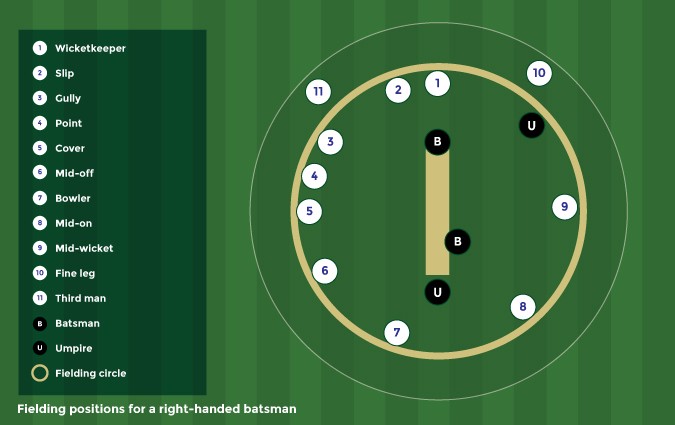Cricket Fielding Positions: Do you know the difference between long off and silly mid-on? If not, then you?re in the right place! The fielding positions in cricket have a variety of different names, some of which sound quite strange! You?ll hear them mentioned all the time by the commentators when you?re watching a game, so it?s important that you get to know the difference between them all.
In this post I will take you through each fielding position and explain whereabouts on a cricket field they are, as well as giving you a few more details on the position such as what situations they are required in, how close they are to the bat, and the abilities that you?ll require if your captain chooses to put you in that position!
If you?re looking for a quick overview, the diagram below will give you a good idea of where each fielding position is on the field?
Diagram Showing Cricket Fielding Positions

This Diagram Of The Cricket Field Shows You Where Each Fielding Position Is
Before we get into the details of each position specifically, let?s run over the basic facts about the cricket field!
Basics of Fielding Positions in Cricket
In terms of fielding positions, I like to divide the cricket field into 3 parts:
The Close Catching Infield ? This area contains the fielders that are the closest to the batsman. Everyone inside this ring will be about 15 yards away or closer! These are often specialist catching positions, with a bit less of a focus on saving runs! If you look at the diagram of the cricket field I included above, the close catching infield is represented by the smallest circle in the centre of the diagram.
The Inner Ring ? This area contains the fielders that will usually be looking to stop the batsmen running singles. Fielders in this area will usually be somewhere up to 30 yards away from the batsman! If you?re fielding in the inner ring, make sure you?re getting yourself in a nice balanced position as the ball is bowled. You should be on your toes, ready to spring left or right in the direction of the ball if it is hit towards you. The inner ring is represented by the second smallest circle on the diagram above.
The Outfield ? This zone contains all the other areas right up until the boundary on all sides of the wicket. Fielders placed in this zone will be there primarily to stop the batsman hitting the ball for boundaries. The outfield is represented by the largest circle in the diagram above.
If you?re not sure which side of the field the off side and the leg side are, then it may be worth clicking this link to read my post where I break down the difference between the two. To keep it simple though, the off side of the batsman will be the side of the field they are facing when they?re in their batting stance. The leg side is opposite of this, therefore it is the side of the field that is behind them when they?re in their stance.
Working out the Cricket Fielding Positions

Most of the positions are named roughly according to a system of polar coordinates?
One word (Leg, Cover, Mid-wicket) specifies the angle from the batsman, and is optionally preceded by an adjective describing the distance from the batsman (silly, short, deep or long).
Leg refers to the Leg side which is the side of the batsman?s leg
On refers to the On side which is batsman?s leg side too
Off refers to the batsman?s off side which is the opposite of the leg side
Distances of the Cricket Fielding Positions from the batsman are described as:
Silly is very close
Short is quite close
Mid is a mid point to the boundary
Long and Deep are closer to the boundary
The angle from the batsmen are described as:
Square is along an imaginary extension of the popping crease
Backward behind square and the batsmen
Forward in front of square and the batsmen
Fine closer to an extension of an imaginary line along the middle of the pitch bisecting the stumps
Wide further from an extension of an imaginary line along the middle of the pitch bisecting the stumps
List of Cricket Fielding Positions positions
1. Wicket Keeper
2. First Slip
3. Second slip
4. Third Slip
5. Fly Slip
6. Long Stop
7. Third man
8. Gully
9. Deep Gully
10. Silly Point
11. Point
12. Deep Point
13. Cover Sweeper
14. Cover Point
15. Extra Cover
16. Deep Extra Cover
17. Silly Mid Off
18. Mid Off
19. Long Off
20. Straight Hit
21. Silly Mid On
22. Mid On
23. Long On
24. Forward Short Leg
25. Short Mid Wicket
26. Mid Wicket
27. Deep Mid Wicket
28. Sweeper
29. Short Square Leg
30. Square Leg
31. Deep Square Leg
32. Leg Gully
33. Long Leg
34. Leg Slip
35. Short Fine Leg
36. Deep Fine Leg


